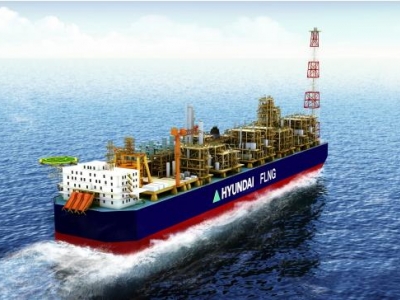Liquefied Natural Gas (LNG) has emerged as an increasingly important clean energy source
Liquefied Natural Gas (LNG) has emerged as an increasingly important clean energy source, particularly following the devastating earthquake and tsunami that struck Japan and triggered one of the world’s worst nuclear disasters.
With the increasing demand for LNG, it has become more attractive to oil and gas majors to develop “stranded gas” in offshore fields. With this in mind, Korea’s Hyundai Heavy Industries, working with German industrial gas and engineering firm Linde AG, has completed developing its own Hyundai FLNG (Floating Liquefied Natural Gas Plant) concept.
The FLNG concept is a special floating vessel that can produce natural gas, liquefy it, and offload it directly to an LNG carrier. HHI conducted risk and safety evaluations of the FLNG and received approval-in-principle from classification society DNV. HHI says the Hyundai FLNG takes 25% less time to build compared to the onshore liquefaction and storage plant, making it an attractive option for oil majors and global shipping companies looking to commercialize stranded gas in offshore fields.
The Hyundai FLNG has an annual production capacity of 2.5 million tons of LNG and can store about 193,800 m3 LNG with its compact size of 355 m in length, 70 m width and 35 m in height.
The FLNG consists of hull and topside facilities. The topside includes not only liquefaction and pre-treatment units, but also utilities such as fresh water supply unit, the air compression, heat source and power generation systems.
“Hyundai FLNG has an efficient and economical production capability in that it just takes about 45 months to build. Considering the fact that the need for the development of stranded offshore gas fields is expected to be on the rise down the road, we will continue to step up our effort to win orders to build Hyundai FLNG,” said Kim Yoon-choon, senior vice president of Hyundai Heavy’s Offshore and Engineering Division who is the charge of the FLNG development project.
HHI has been selected as a core institute for the development of FLNG system engineering by the LNG Plant R&D center of KOGAS. The goal of the project is to develop the Korean FLNG by 2016.
Source: Hyundai Heavy Industries

































































